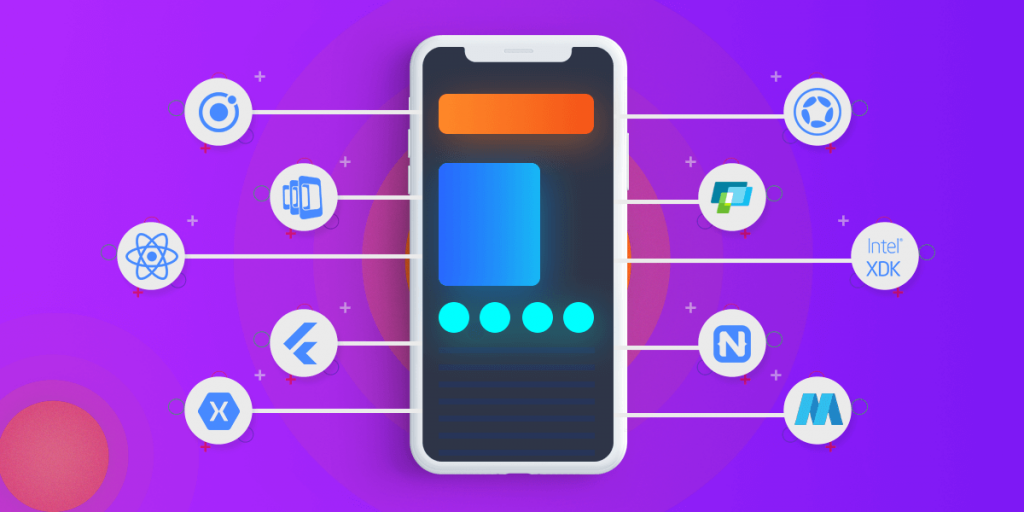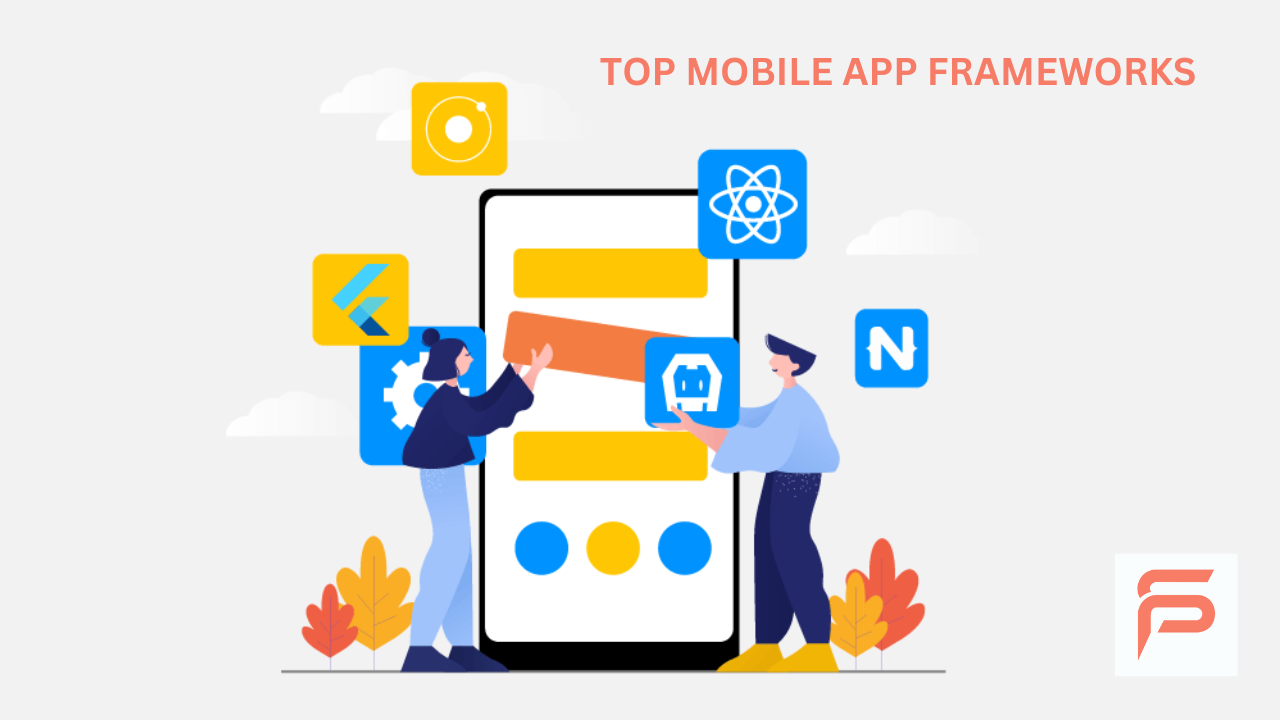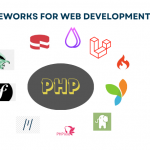Companies who already have a mobile app or are looking to develop one will need to do an extensive research, develop a strategy, plan everything out, and analyse the current mobile landscape in order to succeed in the fiercely competitive digital market.
Although native applications offer an unparalleled experience in terms of appearance and functionality, they are costly to develop and maintain. Because native apps work across several channels and devices, achieving the best level of client engagement can be difficult. The solution is to use frameworks for mobile app development to develop online, hybrid, and cross-platform mobile applications for businesses at a cost.
What is a Mobile App Development Framework?
Businesses have shown that using mobile applications is the most effective approach to expand their clientele. There is never a shortage of innovative app ideas. Everything worked to the advantage of companies that produce applications.
As the name suggests, Mobile App Frameworks are essentially collections of resources and tools—like pre-written code and embedded libraries—that facilitate the creation of full-fledged applications. With the help of these frameworks, mobile app developers can create apps easily from the ground. Because developers just need to search one location for all the information they need, they can quickly and easily construct solutions. Using mobile app development frameworks, developers can reduce the amount of time required for each product variant. They can effectively make use of cross-platform (iOS and Android) compatibility and adhere to industry best practices for designing, developing, and delivering applications.
Mobile app development frameworks are categorised in three types:
Native (Android and iOS): Utilizing native languages and technologies, appropriate to the platform
Cross-Platform (Xamarin, Flutter, and React Native): One codebase to support several platforms
Hybrid (Ionic, PhoneGap and Sencha): Blends web and native technologies
Best Mobile App Development Frameworks

- Flutter
Flutter is an open-source framework by Google that allows developers to create native apps for iOS and Android from a single codebase. This ground-breaking SDK for cross-platform app development is notable for taking a distinct approach to developing apps that have a native-like appearance and feel. It is an unparalleled and incredibly dependable mobile UI framework that expedites the development process and allows for the rapid creation of extraordinary apps.
With widgets, a rendering engine, debugging and integration APIs, and other tools to help developers create and launch stunning mobile applications, Flutter is an all-inclusive and accurate framework. Many well-known companies have used Flutter, including Abbey Road Studios and Google.
Advantages
- Outstanding performance and UIs
- Rich widget library for dynamic user interface
- Robust community and growing ecology
- Hot-reload accelerates the pace of development
Disadvantages
- Steep learning curve
- Limited access to native APIs
- Larger app size than others
2. React Native
React Native is an open-source and cross-platform app development framework created and maintained by Facebook that has swiftly risen to the top among developers’ preferences. Developing mobile apps for iOS and Android is made easier using React Native. The greatest examples of React Native apps include the mobile applications from well-known companies like Tesla, Skype, Amazon Prime and Airbnb.
React Native’s widespread success can be attributed primarily to its quicker development and deployment times. Reusable components, connectivity with third-party plugins, and component-based GUI creation for front-end applications are some of React Native’s other noteworthy characteristics.
Advantages
- Smooth incorporation using native code
- Vibrant, active neighbourhood
- Reusable, modular parts
- Lots of third-party bundles
Disadvantages
- Difficult problems with app debugging
- Restricted access to some features unique to the platform
- Expertise in React and JavaScript is required
3. Xamarin
An additional cross-platform framework for creating iOS and Android applications is called Xamarin. Less code is needed for the applications because they use the C# programming language. This leads to a faster coding procedure. Furthermore, it makes it possible for us to quickly move the scripts between Windows and macOS systems. Microsoft bought out Xamarin.
You could think that because apps are developed so much faster these days, quality and construction are sacrificed in the process of speedier development. On the other hand, apps built with Xamarin provide flawless native functionality in terms of efficiency and quality. Its integration with Microsoft Visual Studio is therefore advantageous for managing app development and increasing productivity. The relationship between the standard code and the core system code is managed by an intermediary layer in Xamarin. With the use of computer languages, frameworks, and tools supported by a vibrant community, programmers may create an environment that includes components, backends, APIs, and more.
Advantages
- Quick Progress
- Touch and appearance of a native application
- Compatibility across a range of gadgets
Disadvantages
- High learning curve for the C# framework
- Upgraded features might need to purchase licenses and components
4. SwiftUI
One of the Best Framework for App Development is Apple’s SwiftUI. Using the programming language Swift, it enables developers to create user interfaces for iOS, macOS, tvOS, and watchOS. The declarative syntax of the framework is its main characteristic. It makes it easy for developers to produce simpler, shorter code which saves a lot of time and work.
With an abundance of pre-built components and special features, SwiftUI provides a full toolkit and APIs that speed up coding and improve end-user experiences. All told, the SwiftUI App Framework makes it easier, faster, and requires no code for developers to create user-friendly solutions for Apple’s platforms.
Advantages
- Performance like Native, platform APIs
- Accessibility, localization and automatic dark mode
- Syntax for Declarative UI
- Live review and interactive developer
Disadvantages
- Only available on Apple platforms
- Familiarity with Swift required
- Limited resources for learning
5. Ionic
Ionic is a clear framework for creating cross-platform, hybrid, and Progressive Web Apps (PWAs) for mobile devices. With the help of Angular and Apache Cordova (PhoneGap), programmers may construct Android and iOS applications that function together effortlessly thanks to the accessible framework, Ionic. The framework helps developers create native apps that are reliable and packed with features. Programmers can use a variety of UI components in the application framework, including as filtering, inputs, views, simple navigation, and actions sheets, thanks to Ionic’s most notable feature.
Advantages
- Creation of multiplatform apps
- Consistent user interface
- Improved and enhanced performance
- User flexibility
Disadvantages
- Less efficient than native frameworks
- Restrictive access to platform-specific APIs
- High learning curve for programmers
6. Corona SDK
Corona SDK is a well-liked cross-platform mobile development framework that supports the creation of 2D applications for all major operating systems. Corona SDK is one of the most flexible frameworks for developing mobile apps, working with both iOS and Android as well as Windows and macOS. It excels in speed and stability due to OpenGL hardware integration and is powered by the Lua scripting language.
The Corona SDK is the foundation for a large number of utility, instructional, and gaming apps that are now on the market. Building the next generation of mobile apps is highly popular and considered to be the most efficient option due to its reputation for expediting and streamlining mobile development.
Advantages
- Quick development using the Lua programming language
- Strong audio and visual skills
- Simple to use and learn for beginners
- Strong IDE
- Huge community and ample documentation
- Options for built-in monetization
Disadvantages
- Reliability on external plugins for specific functionalities
- Reduced adaptability for intricate app logic
- Low 3D graphic support
- Restricted access to low-level device functionalities
7. Apache Cordova
Apache Cordova, previously known as PhoneGap, is the best framework for developer-friendly app development. It is a cross-platform framework for developing apps that uses JavaScript, HTML5, and CSS3 to create mobile apps.
With Cordova plugins, developers can leverage device hardware features like the accelerometer, GPS, and camera to create native-like app experiences. Among Apache Cordova’s noteworthy features are third-party app management tools and a single codebase that speeds up development.
Advantages
- Cross platform compatibility with web technology
- JS interfaces for accessing native APIs
- Cloud-based build up for easy and convenient distribution
- Vast community and ecosystem plugins
- Integration with Adobe Creative Cloud
Disadvantages
- Restricted access to features unique to a platform
- Dependency on other plugins for enhanced functionalities
8. Native Script
It is recommended to use this open-source framework to speed up app code loading. This framework is capable of producing mobile applications with support for Angular, Typescript, CSS, Vue.js, and Javascript. They are preferred by top firms because Native Scripts offer characteristics like business support, full access to Android and iOS APIs, cross-platform application, suitable backend support, and a native user experience without web views.
Advantages
- Supports TypeScript and JavaScript
- Smooth integration between Vue.js and Angular
- Large scale UI elements and plugins
- Rapid hot-reloading
Disadvantages
- Small community
- Fewer unique UI elements to a given platform
9. Framework7
Framework7 is an open-source, simple framework to use and understand. It enables programmers to create desktop, mobile, and Android apps with a native-like interface by utilizing widely used web technologies like HTML5, JavaScript, and CSS3. Framework7 offers further support for Svelte, React, and Vue.js.
The gorgeous UI elements of Framework7, which include a list view, action sheet, popup, layout grid, side panels, and other features, are another alluring aspect of the software. Being the best framework for mobile apps, Framework 7 streamlines, expedites, and eases the development process.
Advantages
- UI and performance like Native
- Supports JavaScript, HTML and CSS
- Numerous widgets and UI elements
- Web developers have an easy learning curve
- Built-in Ios themes and materials
- Active support from the community
Disadvantages
- Exclusive to mobile operating systems (iOS, Android)
- Unsuitable for intricate, highly personalized applications
- Could run into problems with older devices’ compatibility
- Restricted access to hardware features of the device
10. Vue Native
The cross-platform mobile app development framework Vue Native draws equally from the strengths of React Native and Vue.js. It combines the ease of use of Vue.js with the synchronous functionality of React Native to enable developers to create feature-rich, responsive applications. The primary feature of Vue Native is its ability to facilitate real-time testing and debugging of applications. It also offers cross-platform elements like buttons, badges, icons, and lists to enable the creation of high-performing apps.
Developers can access native APIs and provide the kind of performance that customers would anticipate from a native app with Vue Native. Moreover, Vue Native includes excellent tooling similar to that of Vue.js. Developers are rapidly adopting Vue Native as their preferred mobile app development framework due to the mounting need to get every product available on iOS and Android.
Advantages
- Easy to understand and use syntax
- Smooth interaction with the Vue.js framework
- Effectively reusing Vue components
- Direct use of Vue.js plugins to access native APIs
- Hot-reloading for quick iterations in development
Disadvantages
- Smaller community than that of several other frameworks
- Less developed ecosystem in comparison to more well-known frameworks like Flutter or React Native
- Potentially slower performance because of the Vue.js bridge compared to native components
Conclusion
Frameworks for app development make the process of creating apps easier and enable developers to create at a large scale. Fortunately, there are several solutions available to developers when creating an application that works well on a variety of hardware and operating systems.
At Plumscope, we assist our clients in developing mobile applications that foster closer relationships with their clients. Since we are a technology-agnostic company and think that technology may create limitless possibilities, we select the ideal framework for mobile app development for our clients based on the particular project needs, timeframes, budget, and a number of other considerations.
To find out more about the top app development frameworks and how we can support you on your upcoming project, get in touch with our Application Development Experts here.

